
About UsThe Numismatic Bibliomania Society is a non-profit organization devoted to the study and enjoyment of numismatic literature. For more information please see our web site at coinbooks.org SubscriptionsThose wishing to become new E-Sylum subscribers (or wishing to Unsubscribe) can go to the following web page link MembershipThere is a membership application available on the web site Membership Application To join, print the application and return it with your check to the address printed on the application. Membership is only $20 to addresses in the U.S., $25 for First Class mail, and $30 elsewhere. For those without web access, write to: David M. Sundman, Treasurer
AsylumFor Asylum mailing address changes and other membership questions, contact David at this email address: dsundman@LittletonCoin.com SubmissionsTo submit items for publication in The E-Sylum, just Reply to this message, or write to the Editor at this address: whomren@gmail.com BUY THE BOOK BEFORE THE COINSale Calendar |
- WAYNE'S WORDS: THE E-SYLUM JULY 5, 2015
- NBS ELECTION BALLOT ENVELOPES INADVERTENTLY OMITTED
- KOLBE & FANNING TO OFFER MARGO RUSSELL LIBRARY
- NEW BOOK: THE TOP MORGAN DOLLAR VARIETIES
- ANSWER: WHAT DO THESE PHOTOS HAVE IN COMMON?
- NOTES FROM E-SYLUM READERS: JULY 5, 2015
- QUERY: WITH THE COIN COLLECTOR
- QUERY: 1658 CROMWELL CROWN CHOPMARK
- HOWARD BERLIN VISITS OXFORD'S ASHMOLEAN MUSEUM
- THE HISTORY OF WOMEN ON MONEY
- THE HERMANUBIS COLLECTION OF ROMAN EGYPTIAN COINAGE
- 'GOLDEN TICKET' TOKEN STILL GOOD AFTER 250 YEARS
- 1860 BROOKLYN ATLANTICS BASEBALL CARD SURFACES
Click here to access the complete archive
To comment or submit articles, reply to whomren@gmail.com
WAYNE'S WORDS: THE E-SYLUM JULY 5, 2015

New subscribers this week include: John Rogers, courtesy of Steve Roach. Welcome aboard! We now have 1,847 subscribers.
Your Editor is just back from a family vacation, with an overflowing inbox. But to sate your numismatic appetites, here's an abbreviated issue. I'll try to get everything I've missed into the next one. Thanks for your patience.
This week we open with a short update on the NBS election ballots, a note about upcoming Kolbe & Fanning sales, and one new book.
Other topics include Morgan Dollar varieties, the Cromwell Crown, the Ashmolean Museum, and women on money.
To learn more about Steve Roach and Steven Roach, the Heberden Coin Room, Fulvia Flacca Bambula and the 250-year-old 'Golden Ticket', read on. Have a great week, everyone!
Wayne Homren
Editor, The E-Sylum
NBS ELECTION BALLOT ENVELOPES INADVERTENTLY OMITTED
Asylum Editor David Yoon writes:
NBS members who have received the latest issue of The Asylum may notice that the expected envelope for returning the NBS ballot was inadvertently omitted from the mailing. Please mail your ballots to the address indicated on the ballot in any envelope; this will not affect the validity of your ballot.
KOLBE & FANNING TO OFFER MARGO RUSSELL LIBRARY
Kolbe & Fanning Numismatic Booksellers are pleased to announce that we will be offering the numismatic libraries of Margo Russell and Raymond Hale, along with other properties, in two upcoming sales.
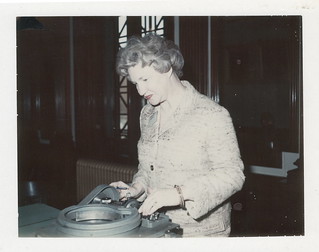 Margo Russell is a name well-known to many in this country. She served as the editor of Coin World from 1962 to 1985, having joined its
staff in 1960 as assistant editor. Not content to simply sit at her desk in Sidney, Ohio, Margo Russell became in many ways the public face
of the hobby, and was a tireless advocate for coin collectors and their concerns. Her personal charm was such that she befriended many whom
she first met in purely professional contexts: Mint Directors Eva Adams and Donna Pope became especially dear friends, as did Chief
Engraver Frank Gasparro. The many effusive inscriptions from authors of the books in her library attest to the widespread esteem in which
she was held.
Margo Russell is a name well-known to many in this country. She served as the editor of Coin World from 1962 to 1985, having joined its
staff in 1960 as assistant editor. Not content to simply sit at her desk in Sidney, Ohio, Margo Russell became in many ways the public face
of the hobby, and was a tireless advocate for coin collectors and their concerns. Her personal charm was such that she befriended many whom
she first met in purely professional contexts: Mint Directors Eva Adams and Donna Pope became especially dear friends, as did Chief
Engraver Frank Gasparro. The many effusive inscriptions from authors of the books in her library attest to the widespread esteem in which
she was held.
The name of Raymond Hale is not as well known to collectors. He was a friend of the firm as well as a customer, and would call every so often to chat about books, bust half dollars and baseball. His death last year at age 50 came as a very unpleasant surprise, and underscored the notion that we’re only the temporary caretakers of the items we collect.
These two libraries, along with other works, are being offered in a pair of sales: an online sale on July 25 and a traditional auction with printed catalogue on August 22. Both sales feature a nice selection of books on ancient and foreign coins, as well as a strong and varied offering of works on U.S. numismatics. More modest works will be offered in the July 25 online sale, with the delicacies held over for the August 22 printed sale.
As a reminder, bidders may participate in both sales in a variety of ways: regular, mail, email, phone, fax or online bidding (live or absentee). Full details will be included with the announcement for each sale. For more information, contact David Fanning at df@numislit.com or see the Kolbe & Fanning website at numislit.com.
Thanks for your continued support!
THE BOOK BAZARRE
NEW BOOK: THE TOP MORGAN DOLLAR VARIETIES
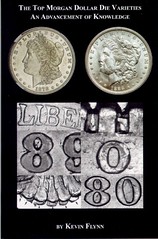 The Top Morgan Dollar Varieties, An Advancement of Knowledge, by Kevin
Flynn is now available. The book is 6 by 9, 190 pages. Softcover only $24.95 plus shipping.
The Top Morgan Dollar Varieties, An Advancement of Knowledge, by Kevin
Flynn is now available. The book is 6 by 9, 190 pages. Softcover only $24.95 plus shipping.
The primary objective of this book is the presentation and advancement of knowledge of many of the top Morgan Dollar die varieties. The evolution in the study of a series requires a more in depth understanding of those coins. Not just that they exist, but how and why they were created and what factors contributed to their creation.
The first chapter explains what criteria was used to select the top varieties. The beginning of the book presents the die making process and provides an analysis on each type of die variety and how it is created. Approximately 70% of the number of Morgan Dollar working dies used by the Philadelphia and branch mints was uncovered and is presented.
For each of the top Morgan Dollar die varieties, a complete description of the variety, including all doubling, repunching, clashing, or any other part of the variety, describing in detail the design elements and other parts of the coin affected. Multiple detailed micro-photographs showing the die variety and also key diagnostics to help identify and distinguish the variety from other that are similar. All diagnostics and where applicable, the die stages. Comments that primarily focus on how the die variety was created, but also present other interesting helpful information. Pricing, cross references, and the primary point of interest. One of the most useful tools in a die variety book is clear photographs displaying the variety; this is one of Flynn’s primary forte, close up photographs.
The National Archives contains letters from those individuals who were responsible for all aspects of the creation of the design, working dies, machinery, striking of coins, and rules and regulations enforced at the mints. These letters can help us learn a great deal about our coins. For examples, correspondence between the Philadelphia and branch mints show that between 1885 and 1898 the branch mints were required to return all working dies to the Philadelphia Mint at the end of each year. Chief Engraver Charles Barber would then determine if unused reverse working dies could be resent to the branch mints. For example, 10 pair of dollar working dies were sent to the Carson City Mint in 1893 with 10 pair returned in January of 1894. Five of the reverses were unused and saved for future use. These eventually became the 5 reverses that were used by the New Orleans Mint in 1900 and became the 1900-O/CC varieties.
There are approximately twenty-five known 1880 Morgan Dollars; the most for any one year in any series. Letters found in the National Archives showed the only time these overdates could have been created. Many of these 1880 Morgan overdates have diagnostics which are not seen on other overdates and were the key to unraveling the mystery on how these overdates were created.
There have been several die varieties that have been misattributed, such as the 1898-O VAM 20 that was simply called a repunched date and is actually the only known large/small date in the Morgan Dollar series. Other varieties have been absolutely refuted such as the 1882-O VAM 3, 4, 5, which cannot be the result of an underlying S mint mark. These are presented along with a complete analysis on these varieties. This includes four different stages of the 1882-O VAM 3 EDS.
For some varieties such as the 1899-O Micro O and 1900-O/CC, as there are several varieties of each, all known varieties are presented with detailed photographs and complete diagnostics to make distinguishing, even in lower grades much easier.
Price for the softcover is $24.95. To order, send a check or money order to Kevin Flynn, P.O. Box 396, Lumberton, NJ 08048. Please include $5 for media shipping or $10 for first class shipping. Please email me at kevinjflynn88@yahoo.com to reserve a copy. See other books available at www.kevinjflynn.com. For dealer discounts for multiple copies, contact Kyle Vick at kylevick@mindspring.com or 770-640-5055.
THE BOOK BAZARRE
ANSWER: WHAT DO THESE PHOTOS HAVE IN COMMON?
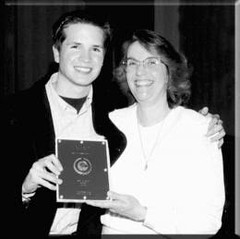

Greg writes:
Photos of ANA outstanding YNs of the year, Steve Roach and Steven Roach, no relation and quite a few years apart.
Pete Smith writes:
1. The first, from Steve Roach of Coin World shows Steve with Fran Lockwood receiving the Central States Best of Show Award in 1997, the same year he received the ANA Outstanding Young Numismatist of the Year Award.
2. The second, showing Steven Roach of Colorado Springs shows Steve with Kim Kiick receiving the ANA Young Numismatist of the Year award in 2015.
To read the earlier E-Sylum article, see:
QUICK QUIZ: WHAT DO THESE PHOTOS HAVE IN COMMON?
(www.coinbooks.org/esylum_v18n26a21.html)
NOTES FROM E-SYLUM READERS: JULY 5, 2015
Tales From the Bourse
Dennis Tucker writes:
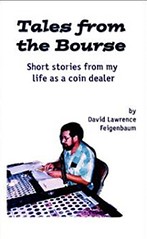 Interesting timing that John Feigenbaum’s remembrance of his father’s book, Tales From the Bourse,
was published last week. Here at Whitman Publishing headquarters in Atlanta, we’ve been moving our numismatic library from one part of
the compound to another closer to the Editorial Department. Last week I was deep in the archives browsing through the books when I found
a copy of Tales. I was familiar with the volume but had never read it; I took it back to my office and made it my lunchtime
reading material. Many thanks to David Lawrence Feigenbaum for writing this fun, poignant, and informative book. His dedication to seeing
it through to completion and publication not long before his death, despite his physical challenges, is inspiring. Feigenbaum’s love of
his family is evident throughout the book, and it was nice to read his son John’s recollections a few days later.
Interesting timing that John Feigenbaum’s remembrance of his father’s book, Tales From the Bourse,
was published last week. Here at Whitman Publishing headquarters in Atlanta, we’ve been moving our numismatic library from one part of
the compound to another closer to the Editorial Department. Last week I was deep in the archives browsing through the books when I found
a copy of Tales. I was familiar with the volume but had never read it; I took it back to my office and made it my lunchtime
reading material. Many thanks to David Lawrence Feigenbaum for writing this fun, poignant, and informative book. His dedication to seeing
it through to completion and publication not long before his death, despite his physical challenges, is inspiring. Feigenbaum’s love of
his family is evident throughout the book, and it was nice to read his son John’s recollections a few days later.
To read the earlier E-Sylum article, see:
BACKSTORY: TALES FROM THE BOURSE (www.coinbooks.org/esylum_v18n26a08.html)

QUERY: WITH THE COIN COLLECTOR
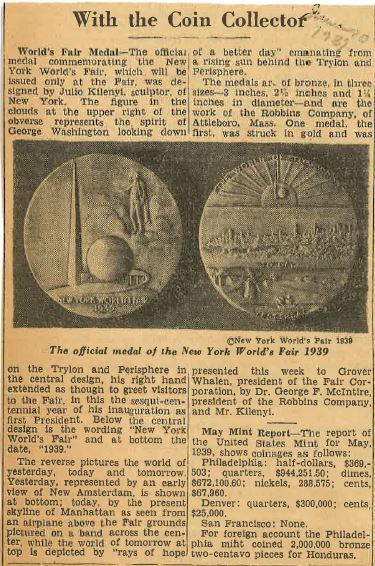
Arnold Tescher writes:
In my continuing job as volunteer archival assistant at the American Numismatic Society, I am working on a scrapbook compiled in the late 1930s, containing clips of a running numismatic column entitled "With the Coin Collector." This column appeared weekly in the New York Herald Tribune Sunday edition from about 1937 to 1941, based on the range of clips in the scrapbook.
The majority of the articles deal with foreign and ancient coins, but, as the sample shown here, there are also articles about American coinage. Thus far I have been unsuccessful in determining any information about this long running column, such as who wrote it; how long did it actually run; did it appear in any other newspaper; etc. Any help from readers would be most welcome.
THE BOOK BAZARRE
QUERY: 1658 CROMWELL CROWN CHOPMARK
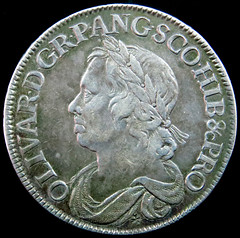
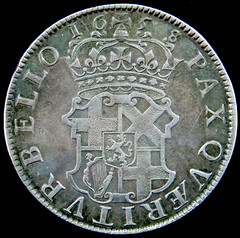
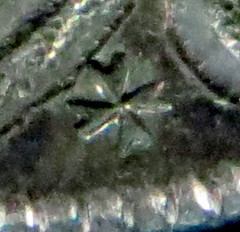 Neville Eilbeck (Hillesden@hotmail.com)
writes:
Neville Eilbeck (Hillesden@hotmail.com)
writes:
I was wondering if any E-Sylum reader might be able to throw some light on the chop mark on this Oliver Cromwell Crown of 1658.
Weight is 29.91gms, Cromwell crown 1658/7, early production. I suspect these were used for trade activities hence the interest to find out if this chop mark can be identified as it might prove the theory that these were in fact trade pieces. A Dutch connection is possible.
THE BOOK BAZARRE
HOWARD BERLIN VISITS OXFORD'S ASHMOLEAN MUSEUM
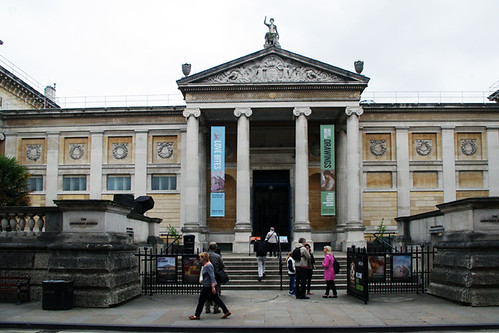
The entrance on Beaumont Street to the world’s first university museum, completed in 1683.
After our nine days traveling through southern Spain and Gibraltar, we left for a two day stay in London before heading home. Following our arrival in London, we took a day trip via train to Oxford to tour the town and to visit the Heberden Coin Room in the lower level of the Ashmolean Museum of Oxford University. It is the world’s first university museum, whose first building was completed in 1683. Although it is normally closed on Mondays, this Monday was a “Bank Holiday” in the UK and therefore the museum was open.
As often as I get through London, the last time I visited the museum was back in 2007 during its 3-year, £60-million renovation program. Then, only a few major items from each archeological area were displayed in a single room. I would now be able to see the transformed product housing parts of its noted numismatic collection.
The Ashmolean Museum reopened to the public on November 7, 2009 and included 38 new galleries. The museum’s numismatic collection of the Heberden Coin Room is chiefly displayed in the new gallery. Additional specimens are also located in twenty five other galleries throughout the museum where they complement other objects from the museum’s collection. Additionally, coins feature prominently in graphic elements that support displays throughout the entire Museum.
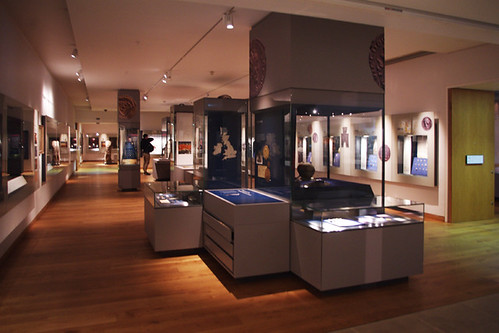
The gallery is divided into three main areas: the north and south walls, and a central aisle of free-standing cases. There is also space for a temporary exhibition on the west wall. The gallery is composed of object displays and hands-on interactive components, supported by extensive graphic elements.
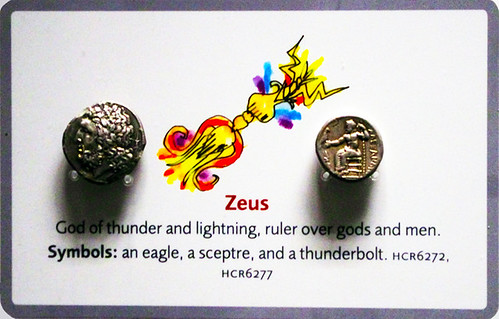
One of many examples of coins of the theme, “Greek Gods and Heroes.”
The north and south walls, carry two broad themes. The north wall’s theme is “Money: The Value of the Past.” In nine displays from ancient Greece to modern Britain, this wall, showcases world cultures through the coins they produced. The displays are augmented by graphic elements such as enlarged pictures of coins and images of prints, architecture, icons and sculpture.
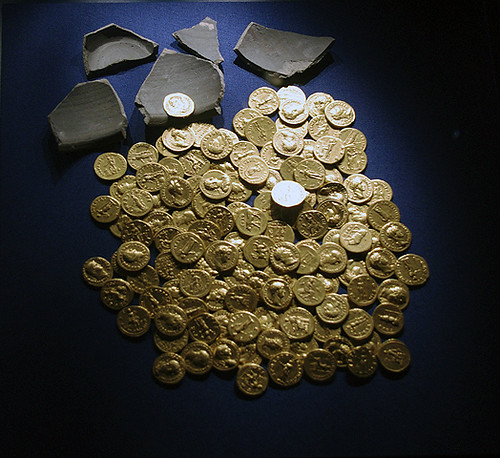
Coins from the Didcot hoard.
“What’s it Worth?” is the theme of the south wall, which provides an overview of money through thematic displays that emphasize the physical, cultural and historical aspects of money – articulated through a selection of objects and graphic panels.
The central aisle has three important focuses – displays concentrating on the Greeks, the Romans in Britain, the Anglo-Saxons, the Tudors, and the Victorians. The Victorians are shown through a selection of medals, rather than coins, thus bringing a significant part of the Coin Room’s non-monetary collection into the gallery’s domain. There are displays for the Oxford Crown of Charles I as the first English coin to depict a town when King Charles I moved his capital to Oxford, having been expelled from London by Parliament; the Crondall Hoard of the earliest Anglo-Saxon gold coins discovered in 1828, which marked the reintroduction of coinage into Britain two centuries after the abandonment of the province by the Romans; and the Chalgrove Hoard, discovered in 2003 near Oxford. There is also a case for the Didcot hoard of Roman aurei.
There are several interactive elements offering educational and cultural information through tactile and visual activities such as “Design Your Own Coin.” Like almost all public museums in the UK, admission is free, although there is a non-obligatory donation box inside near the museum’s entrance.
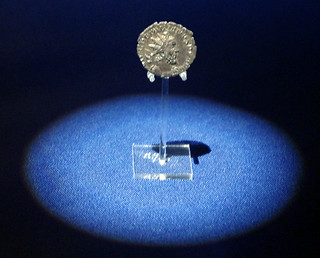
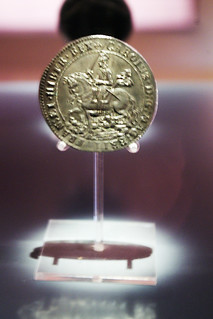
Left: Found in the 2003 Chalgrove hoard is this single radiate of Domitianus, a formerly unknown usurper who ruled Britain for only four days in 271 AD. This coin is the only evidence pointing to the existence of this ruler.
Right: The famed Oxford Crown of Charles I.

THE HISTORY OF WOMEN ON MONEY
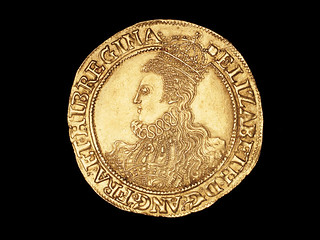 The current debate over American currency resonates with the complicated history of how and why women have been represented on money, a
history that provides insight into the ways women have wielded and represented authority through the ages.
The current debate over American currency resonates with the complicated history of how and why women have been represented on money, a
history that provides insight into the ways women have wielded and represented authority through the ages.
The first non-mythological or allegorical woman to appear on a Roman coin was the third wife of Mark Antony, Fulvia Flacca Bambula (c. 83–40 B.C.), who wielded considerable influence during the rocky period of civil war following the assassination of Julius Caesar. While Antony was in Alexandria, consorting with Cleopatra, Plutarch writes, Fulvia was “carrying on war at Rome with [Octavius] Caesar in defense of her husband’s interests.”
Around this time, the Roman mint issued coins depicting Fulvia as the goddess of victory, a recognition both of her service to Rome and of her skill as a leader, albeit as a proxy for Antony. Cleopatra, who ascended to the Egyptian throne, alongside her brother, after their father died in 51 B.C., was a rare example in the ancient world of a woman who held formal political leadership and appeared on coinage by virtue of her own official authority.
Other women who appeared on Roman currency were honored largely because they were related to male leaders: Octavia the Younger, a sister of Augustus Caesar; Livia Drusilla, the mother of the Emperor Tiberius; and Antonia the Younger, a daughter of Mark Antony and Octavia. The same was true of the mothers, daughters, and sisters of powerful men who appeared alone on Byzantine coins. In their essay “The Gender of Money,” the University of Birmingham professor Leslie Brubaker and her student Helen Tobler argue that royal women made it onto coins in the Byzantine Empire because they represented the continuity of the dynastic line—a bulwark against upheaval and chaos.
This association of stability with a coin bearing a woman’s face became more tangible in England centuries later, with the financial reforms introduced by Elizabeth I. At the time she was crowned, in 1558, the country’s currency had been drastically devalued. Her father, Henry VIII, had, in order to support his military campaigns against France and his personal extravagances, used one of the only methods available to monarchs to raise cash before the advent of national debt: minting coins with just a touch of silver and gold and circulating them at the same value as coins made entirely of precious metals. Once people caught on to the fact that the new coins were comprised primarily of copper, they began hoarding the old ones, which made it harder for the Crown to source gold. The copper coins also adversely affected foreign transactions, undermining confidence in the value of English currency and sullying England’s international reputation.
After ascending to the throne, Elizabeth and her advisers William Cecil and Sir Thomas Gresham devised a rescue plan. The Royal Mint soon began to melt down the debased currency, and new coins, bearing Elizabeth’s impressive profile, were minted in precious metals. The currency was restored in the eyes of the public, and the crown earned the tidy sum of fifty thousand pounds (about twenty-two million of today’s dollars) via seigniorage.
Elizabeth’s portrait on the new coins made literal the association between her person, her title, and the fiscal power of the country she ruled—a kind of financial body politic. Other powerful European women appeared alone on coins in Elizabeth’s wake, among them Anne of England (who ruled from 1702–1707), Maria Theresa of Austria (1740–1780), Catherine II (the Great) of Russia (1762–1796). As the historian William Monter notes, though, double portraiture was also common in Europe during those centuries, with monarchs such as Mary, Queen of Scots, depicted alongside their husbands. William and Mary, of England, and Ferdinand and Isabella, of Spain, also appeared in this style.
To read the complete article, see:
The New Ten’s Two-Body Problem
(www.newyorker.com/business/currency/the-new-tens-two-body-problem)

THE HERMANUBIS COLLECTION OF ROMAN EGYPTIAN COINAGE
Classical Numismatic Group of Lancaster, Pennsylvania and London, England is pleased to present the Hermanubis Collection of Roman Egyptian Coinage, the first part of which is in the firm’s current online auction 355, closing on July 15, 2015. Further selections from the Hermanubis Collection will be offered in both future CNG electronic and printed catalogues.
The Hermanubis Collection was assembled with a focus on both quality and rarity. It is expected that this collection will help create a new generation of collectors for the specialized, but popular area of Alexandrian/Roman Egyptian coinage. In CNG E-Sale 355, a group of 72 Billon and Potin tetradrachms is offered from the reigns of Nero through Philip I. Just a few of the highlights are featured below:
Unpublished Commodus as Herakles Tetradrachm Type Lot 398. Estimated at $300.
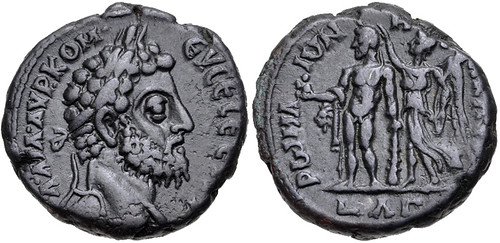
EGYPT, Alexandria. Commodus. AD 177-192. BI Tetradrachm (24mm, 12.28 g, 12h). Dated RY 33 of Marcus Aurelius (AD 192). Laureate head right / ΡωΜΑΙωΝ Η[ΡΑΚΛΕΑ], Commodus as Herakles standing facing, head left, holding the Golden Apples of the Hesperides and leaning on club, lion skin draped over his right arm; behind him, Nike standing left, crowning him with her right hand, holding palm frond with her left; L ΛΓ (date) in exergue. Köln –; Dattari (Savio) –; K&G –; Emmett –. VF, dark gray-brown surfaces. Very rare.
From the Hermanubis Collection.
Apparently unpublished in the standard references with Nike standing behind Commodus as Herakles.
Graceful Bust of Isis Lot 418. Estimated at $250.
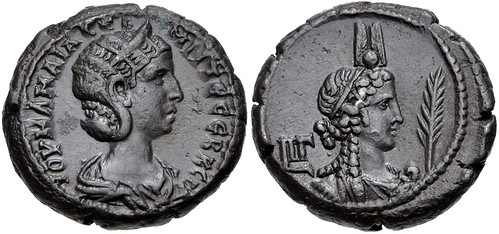
EGYPT, Alexandria. Julia Mamaea. Augusta, AD 222-235. Potin Tetradrachm (24mm, 13.90 g, 12h). Dated RY 13 of Severus Alexander (AD 233/4). Draped bust right, wearing stephane / Crowned and draped bust of Isis right; L IΓ (date) behind, palm frond before. Köln –; Dattari (Savio) 4496; K&G 64.114; Emmet 3211.13. Nice EF, dark gray-brown surfaces.
From the Hermanubis Collection.
Lot 443. Estimated at $250.
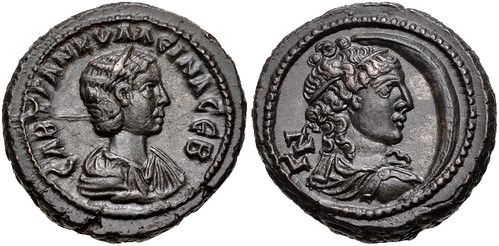
EGYPT, Alexandria. Tranquillina. Augusta, AD 241-244. Potin Tetradrachm (23mm, 11.62 g, 12h). Dated RY 7 of Gordian III (AD 243/4). Draped bust right, wearing stephane / Draped bust of Selene right; crescent moon before; L Z (date) behind. Köln –; Dattari (Savio) 4838; K&G 73.38; Emmett 3460.7 (R5). EF, dark gray-brown surfaces. Rare.
From the Hermanubis Collection.
Superb Depiction of Isis Lot 450. Estimated at $250.
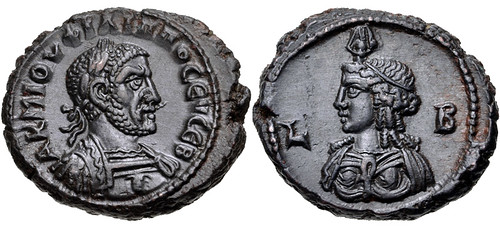
EGYPT, Alexandria. Philip I. AD 244-249. Potin Tetradrachm (24mm, 11.38 g, 12h). Dated RY 2 (AD 244/5). Laureate and cuirassed bust right / Crowned and draped bust of Isis left; L B (date) across field. Köln –; Dattari (Savio) 4888; K&G 74.26; Emmett 3489.2. EF, dark gray-brown surfaces.
From the Hermanubis Collection.
CNG is always accepting consignments for its future electronic and printed auction sales. For further details, consignment deadlines, and any additional information, please contact CNG, Inc. at:
Classical Numismatic Group, Inc.
P.O. Box 479
Lancaster, PA 17608-0479
Telephone: (717) 390-9194
Fax: (717) 390-9978
Email: cng@cngcoins.com
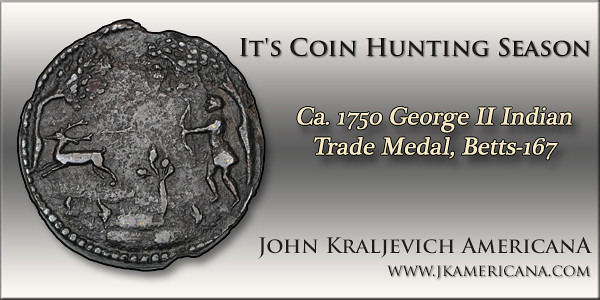
'GOLDEN TICKET' TOKEN STILL GOOD AFTER 250 YEARS
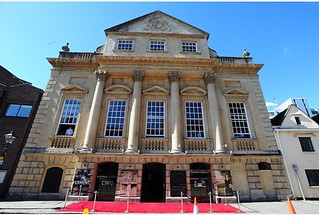 A rare 'golden ticket' which
gives its bearer free lifetime entry to Britain's longest-running theatre has been honoured - 250 years on.
A rare 'golden ticket' which
gives its bearer free lifetime entry to Britain's longest-running theatre has been honoured - 250 years on.
The silver coin, gilded in gold, was one of only two ever made to mark the founding of the Bristol Old Vic in 1766.
They were originally presented to a couple called Mr and Mrs Crump who persuaded landowners to allow the theatre to be built.
For the "great trouble and expense" the Crumps went to, Bristol Old Vic granted the couple and their family and friends free, unlimited entry to all shows.
To read the complete article, see:
'Golden
ticket' silver coin for Bristol Old Vic lifetime free entry discovered in French home
(www.westerndailypress.co.uk/Golden-ticket-silver-coin-Bristol-Old-Vic/story-26797579-detail/story.html)
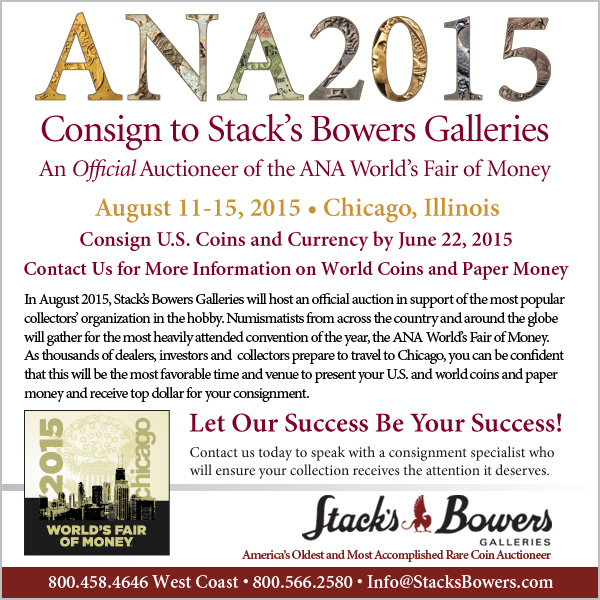
1860 BROOKLYN ATLANTICS BASEBALL CARD SURFACES
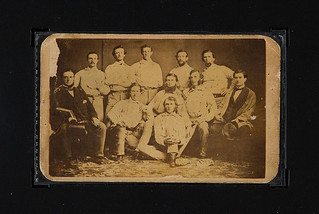
1860 Brooklyn Atlantics Baseball Card, passed down in the family of player Archibald McMahon for more than 150 years, will be on the block Thursday, July 30, 2015, as part of Heritage Auctions' Platinum Night Sports Auction, held in conjunction with the 2015 National Sports Collectors Convention in Chicago. It is expected to bring $50,000+.
"This is a seminal artifact, not just of baseball, but of American history," said Chris Ivy, Director of Sports Auctions at Heritage. "It ranks with the most significant mementos of the sport's infancy ever to surface and is, quite possibly, the only team card on Earth printed before the first drop of blood was spilled in the American Civil War."
The card is being offered by western Massachusetts resident and New York native Florence Sasso, 75, the great grand-niece-in-law of Archibald McMahon, one of the players on The Brooklyn Atlantics. The card, which was given to Sasso by her mother, the late Mildred Sasso, spent the decades with various family members before ending up with Sasso's mother, who kept it in a secret compartment in a piece of furniture the family inherited from an uncle.
Once the card was given to Sasso, she moved it from place to place — often from safekeeping in the pages of a book into another book — until she realized that the card, aside from being a link to her family history, could be quite valuable. Without children to pass it on to, Sasso has decided the time has come for a new caretaker for the artifact.
"This story of this card is also my mother's story," said Sasso. "She loved baseball and she kept it all those years. She always wanted it to take care of me and now it will."
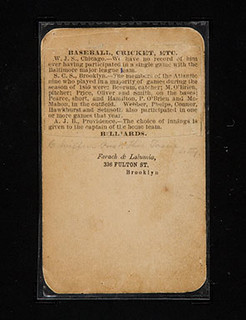 The subject of the card is the Atlantic Base Ball Club of Brooklyn, considered the
first Champion of our National Pastime, as well as the sport's first dynasty. The Atlantics served as a founding member of the
sport's first organized league, the National Association of Base Ball Players, and held the Championship from 1859 through the
war-shortened season of 1861 before finally surrendering supremacy to archrival Eckford of Brooklyn in 1862.
The subject of the card is the Atlantic Base Ball Club of Brooklyn, considered the
first Champion of our National Pastime, as well as the sport's first dynasty. The Atlantics served as a founding member of the
sport's first organized league, the National Association of Base Ball Players, and held the Championship from 1859 through the
war-shortened season of 1861 before finally surrendering supremacy to archrival Eckford of Brooklyn in 1862.
The card was passed down through the family of Archibald McMahon, an outfielder for the squad. That provenance can be traced back as far as 1928, with the obituary of 92 year old John McMahon, Archibald's brother, from which the following is excerpted:
"He also was an ardent baseball fan and had a picture in his home of the original Atlantics team, of which his brother, Archibald McMahon, was a member.
To read the complete article, see:
Pre-Civil
War baseball card, passed down in one family for 155 years, is ready for auction
(http://artdaily.com/news/79683/Pre-Civil-War-baseball-card--passed-down-in-one-family-for-155-years--is-ready-for-auction#.VZSDQfm6fIU)
